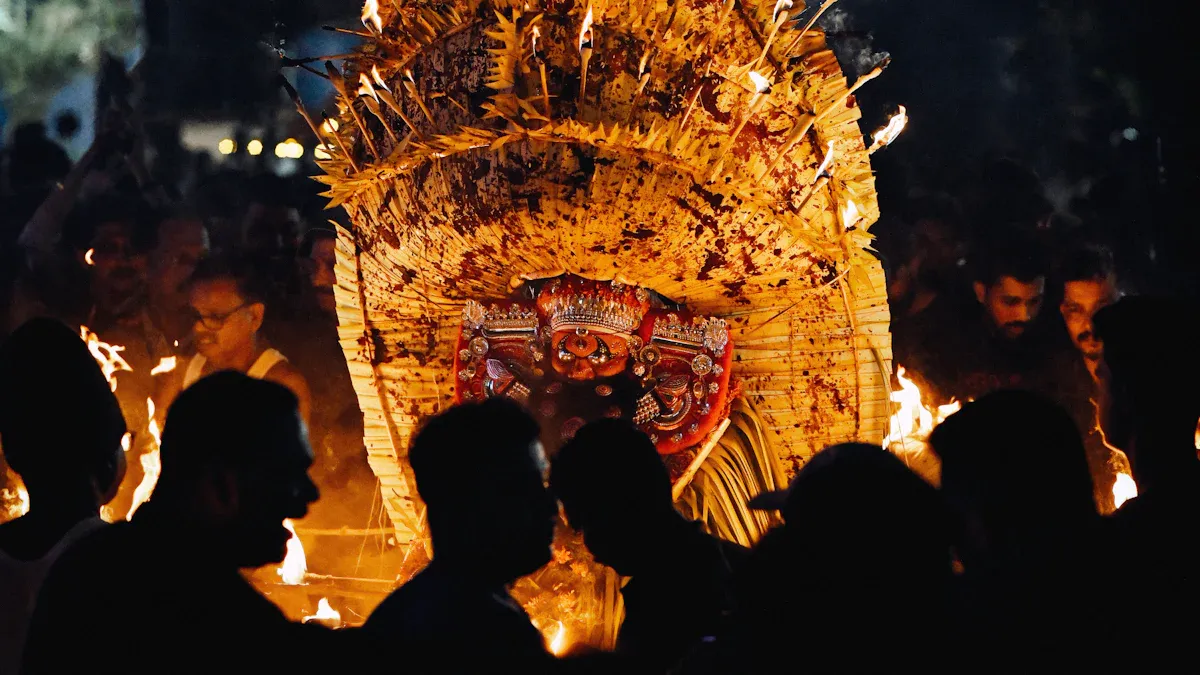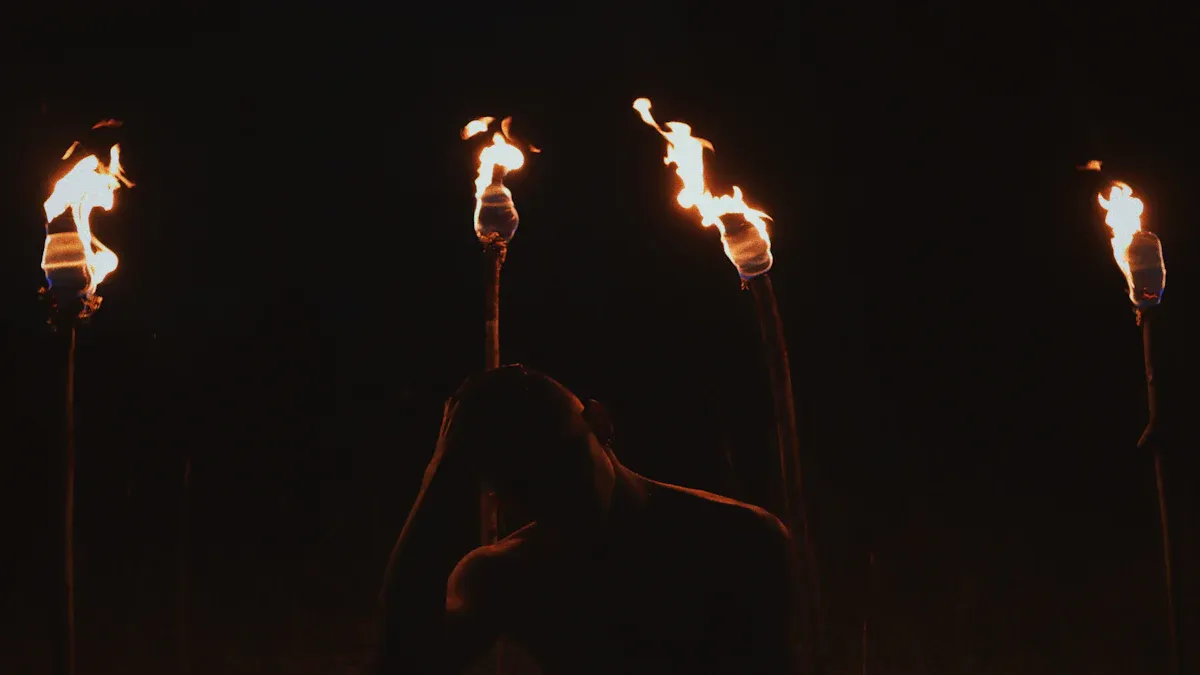
Torch lighting symbolizes important human values. 隨著時間的推移, it has stood for learning, togetherness, and customs. Lighting a torch often shows sharing ideas or beliefs between people. 例如, in 1961, Tanzania created the Uhuru Torch to show freedom and independence. This worldwide symbol goes beyond cultural differences. It also stands for hope, peace, and strong human determination.
From old traditions to today’s events, torch lighting still motivates people. Its lasting importance reminds us of our common dreams for a better world.
Historical Origins of Torch Lighting

Ancient Greek and Roman Traditions
Torch lighting in ancient Greece and Rome symbolized sacred rituals and mystical experiences. The Greeks used torches in special ceremonies like the Eleusinian Mysteries. Light in these events stood for learning and a connection to the divine. Homer’s ancient poems, written about 3,000 years ago, mention pine torches. This shows how important torches were in daily life back then. In Olympia, a sacred flame burned in the Temple of Hera. It stood for peace and unity during the ancient Olympic Games.
The Romans also valued torch lighting in their traditions. They used torches in weddings, funerals, and religious celebrations. Torches lit up processions and marked life changes, like the soul’s journey after death. These customs show how light connected people to their gods and cultural practices.
🏺 Key Highlights:
Homer’s poems mention pine torches.
The Olympic flame started in ancient Greece.
Torches marked transitions in Roman rituals.
The Role of Fire in Religious Ceremonies
Fire has always been a powerful symbol in religious practices. Many ancient cultures saw fire as a sign of divine presence, safety, and cleansing. 例如, in the Old Testament, Yahweh appeared to Moses in a burning bush. He also guided the Israelites with a pillar of fire. These stories show fire as a symbol of God’s guidance and promises.
In ancient Persia, the Sadeh festival honored fire as a force against darkness and evil. Women lit their home fires from a shared flame, spreading blessings to their families. This tradition is touching because it shows how fire brought people together and gave hope during tough winters.
“On the morning after the lighting of the communal fire, women would go to the fire and from it light their household fire censer. Taking back the fire to their homes represented the taking back of the blessing of the sadeh fire, thereby spreading the blessings and protection against evil to every household in the community.”
Symbolism of Light in Early Cultures
Light has always held deep symbolic meaning in early cultures. It stood for life, hope, and spiritual connection. Archaeologists found that ancient people used oil lamps not just for light but also in rituals. 例如, the Lascaux cave paintings, made 15,000 years ago, were likely lit by burning animal fat. This shows how light was part of both art and spiritual life.
In ancient Egypt, torches and oil lamps were key in funeral rituals. The Book of the Dead shows tools like “wicks-on-sticks,” which symbolized the journey to the afterlife. Similar items were found in King Tutankhamun’s tomb, proving how important light was in guiding souls.
“Oil lamps were utilized in various ways by ancient cultures, serving not only practical lighting needs but also playing a crucial role in rituals and symbolism. In religious settings, they were often used to illuminate temples and shrines, and were integral to rituals, symbolizing blessings and the afterlife.”
🔥 Key Highlights:
Lascaux cave paintings used light for art and rituals.
Egyptian funeral rituals used torches and oil lamps.
Light symbolized blessings and the afterlife in many cultures.
The Olympic Torch and Its Symbolism
The History of the Olympic Flame
The Olympic flame has a long history linking old and new traditions. In ancient Greece, a special fire burned at Hestia’s altar during the Olympics. This fire showed the gods’ presence and unity among athletes. Myths also mattered, like Prometheus taking fire from the gods, making it sacred in Greek culture.
The modern Olympic flame first appeared at the 1928 Amsterdam Games. It was lit in a bowl on the Marathon Tower, starting a new tradition. In 1936, the cauldron lighting ceremony became official at the Berlin Olympics. The flame was lit in Olympia, Greece, and carried to the host city, creating the Olympic torch relay.
“The Olympic flame links ancient and modern Games, joining years of tradition.”
Year/Event | Description |
|---|---|
Ancient Greece | Special fire burned at Hestia’s altar during ancient Olympics. |
1928 | Flame first seen in modern Olympics at Amsterdam Games. |
1936 | First torch-lighting ceremony held in Olympia, Greece. |
The Olympic Torch Relay Tradition
The Olympic torch relay honors the flame’s journey across countries. This started in 1936, inspired by old Greek torch races. The relay begins in Olympia, where the flame is lit with the sun and a mirror. It travels through many nations, carried by torchbearers showing unity and Olympic values.
The relay has changed over time. 例如, in the 2004 Athens Games, local and global elements were mixed to show cultural importance. The London 2012 Olympics highlighted the relay’s impact on communities, focusing on citizen media’s role in telling stories.
🌍 Key Highlights:
The relay links old rituals to new traditions.
It celebrates unity and cultural variety.
Citizen media helps create shared spaces during the relay.
Symbolic Meanings of the Olympic Torch
The Olympic torch holds deep meanings that touch people worldwide. It stands for enlightenment, peace, and the Olympic spirit. Lighting the cauldron at the opening ceremony marks the Games’ start and nations’ unity. The flame’s journey in the relay shows perseverance and hope.
The torch also shows Olympic values like excellence, friendship, and respect. Its meaning goes beyond sports, inspiring people to aim for a better world. The flame’s lasting nature reminds us of the timeless link between old traditions and new goals.
“The Olympic torch is more than a flame; it is a symbol of hope and shared dreams for humanity.
Torch Lighting in Modern Ceremonies
Torchlight Ceremonies in Cultural Events
Torchlight ceremonies are important in cultural events worldwide. They often show shared values, traditions, and peace. A well-known example is the Olympic torch relay, which started in 1948. The torch was carried from Greece to London. This event renewed global interest in the Olympics and began a lasting tradition.
“The Olympic torch relay, starting in 1948, is a modern example of torch lighting. It traveled from Greece to London, reviving global Olympic excitement and becoming a key tradition.”
Torchlight ceremonies are also part of festivals, parades, and national events. They unite communities and create shared purpose. Whether local or global, these ceremonies remind us of friendship and togetherness.
Torch Lighting in Memorials and Celebrations
Torch lighting connects remembering the past with celebrating the future. It honors history while giving hope. One example is the torch-lighting at Theodor Herzl’s grave, started in 1949 by Gadna members and the Speaker of the Knesset. In 1950, it became an official event, symbolizing unity and remembrance.
Year | Event Description | Importance |
|---|---|---|
1949 | Gadna members and the Speaker of the Knesset began the torch-lighting at Theodor Herzl’s grave. | Shows national unity and remembrance. |
1950 | The ceremony became official. | Marks its formal role in Israel’s celebrations. |
N/A | Includes mourning taps, Yizkor prayer, and a celebratory part. | Combines remembrance and celebration, showing resilience. |
Memorial torch ceremonies often include quiet moments like prayers or silence. These moments lead into celebrations, showing strength and peace. The lighting becomes a sign of hope and determination.
The Role of Torch Lighting in Unity and Peace
Torch lighting is a strong symbol of unity and peace. It connects people from different cultures and nations. The Olympic torch shows this by standing for peace, strength, and human success through sports.
🌍 Key Examples:
The Olympic torch shows unity and peace, reflecting host nations’ values.
The torch relay highlights teamwork and cultural variety.
The flame represents human strength and global friendship.
Torchlight ceremonies bring people together, building respect and belonging. They remind us that even in hard times, peace and unity are possible.
Specific Symbolic Meanings of Torch Lighting
Enlightenment and Knowledge
Torch lighting shows enlightenment and the search for knowledge. Light has always stood for learning and clear thinking. The Greeks held the Lampadedromia, a torch race to relight sacred fires. This showed how important light was in their traditions. In the Tabernacle, an eternal lamp burned, symbolizing God’s presence and wisdom.
In stories and art, fire sparks human ideas. It is often called the “torch of knowledge,” helping people move away from ignorance. Diwali, the Hindu festival of lights, celebrates knowledge defeating darkness. This highlights how light represents wisdom and understanding. These examples show how torch lighting connects us to the endless search for truth.
🔥 Key Examples:
Lampadedromia honored sacred fire in ancient Greece.
Diwali celebrates light winning over ignorance.
The “torch of knowledge” symbolizes learning and wisdom.
Freedom and Liberation
Torch lighting strongly represents freedom and liberation. It has been used in events and movements to show the fight against unfairness. Enslaved people used torches in funeral rituals, keeping their traditions alive despite hardships. This made the torch a “symbol of freedom.”
The Olympic flame also stands for liberty. Its journey across countries shows shared values of success and striving for greatness. The flame reminds us to stay strong and work for a better future. Whether in history or today, 這 “torch of truth” inspires freedom and unity.
🌍 Key Highlights:
Enslaved communities used torchlight to keep traditions alive.
The Olympic flame shows freedom and human success.
The “torch of truth” inspires strength and unity.
Hope and Perseverance
Torch lighting symbolizes hope and perseverance. The Olympic torch, carried across the world, stands for unity and excellence. From lighting the cauldron to the Torch Run, it connects athletes, nations, and fans in celebrating achievements.
The Flame of Hope, used in Special Olympics, shows the hard work of athletes, coaches, and families. It represents dreams and effort, reminding us of hope’s power. This flame shows the strength needed to overcome challenges and reach goals. Torch lighting, in sports or events, inspires people to aim higher.
“This flame, speaking a universal language, brings hope for a brighter future.”
✨ Key Takeaways:
The Olympic torch shows strength and success.
The Flame of Hope inspires effort and achievement.
Torch lighting unites people with shared dreams.
The Universal Appeal of Torch Lighting
Why the Torch Resonates Across Cultures
The torch is meaningful because it stands for freedom, knowledge, and inspiration. Fire has always been special in human history. It links us to old traditions and shows how far humans have come. Learning to control fire was a big step for early people. It turned survival into culture, making the torch a sign of human success.
Here’s why the torch is important in many cultures:
Aspect | Description |
|---|---|
Historical Significance | Fire has been seen as sacred for thousands of years. |
Symbolism | The torch stands for freedom, learning, and inspiration. |
Cultural Resonance | Fire mastery shows human growth and adds meaning to the torch. |
When I think of the torch, it feels like more than just light. It connects the past to today, bringing old lessons into modern life. This makes the torch a symbol that crosses cultures and beliefs.
Timelessness of the Symbol in Modern Society
Torch lighting stays important because it gives hope and courage. I often think about how symbols like the torch change with time but keep their meaning. Florence Nightingale, called the “lady with the lamp,” is a great example. During the Crimean War, her lamp showed care and kindness. Her story still inspires people today, proving the torch’s meaning lasts through time.
“The light of the soul sparks, flares, and builds fires. Showing kindness and bravery in dark times is a great act.”
Today, torch lighting is part of events, protests, 和慶祝活動. It brings people together and reminds us of shared values. Whether it’s the Olympic flame or a candle at a vigil, the torch shows strength and the human spirit’s ability to keep going. I think this lasting meaning is why the torch inspires people across generations.
Torch lighting stands for values that bring people together. From old caves to today’s events, it has always meant learning, peace, and shared dreams. Early humans used torches in caves not just to see but to light up their art. This shows how light connects to creativity and finding meaning.
Now, lighting a torch still inspires us. It reminds us of our shared path toward knowledge, freedom, and hope. Whether at the Olympics or in memorials, this tradition links history to today, showing its lasting ability to unite people.
常問問題
What does the torch symbolize in the Olympic opening ceremony?
It stands for unity and tradition. The torch links old and new Olympic Games. It shows shared values of athletes and nations. It spreads a message of peace, inspiring teamwork and hope worldwide.
Why is the torch relay important?
It honors global unity. The relay moves the flame across many countries. It celebrates teamwork and cultural differences. Each torchbearer shows perseverance and the Olympic spirit, bringing people together.
How does torch lighting inspire hope?
It reminds us to stay strong. The flame’s journey shows resilience and human strength. Its presence in ceremonies encourages us to face challenges and dream of a better future.
Why is fire used as a symbol in ceremonies?
Fire stands for life and wisdom. Ancient people saw fire as sacred and divine. Today, it still symbolizes knowledge, freedom, and the strength of the human spirit.
How does the torch promote a message of peace?
It connects people everywhere. The torch’s journey shows shared dreams for harmony. Events like the Olympic opening ceremony highlight unity and understanding among nations.





